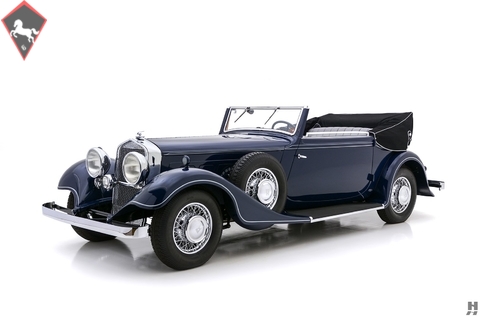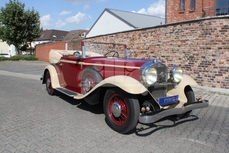Horch 8 5 ltr. Typ 480/500/500A/500B/780/780B 1934
General description :
Once the crown jewel of the Auto Union Empire, Horch stands proudly among the German motoring industry's most prestigious classic era marques. August Horch founded his eponymous firm in 1900, and it steadily grew in prominence thanks to a commitment to innovation and engineering excellence. Horch went head-to-head with the likes of Daimler and Mercedes through the 1920s and 1930s, joining Audi, DKW, and Wanderer to form Auto Union in 1932. Later in the 1930s, the Auto Union Grand Prix team famously locked horns in a fierce battle with Mercedes-Benz for supremacy on European racing tracks.
In March of 1932, Horch introduced the powerful new 700-series, a suitable flagship for the new Auto Union concern. Buyers could select one of three versions of the new overhead-cam inline eight-cylinder engine, designed in-house by Fritz Fiedler. At the top of the model range sat the 4.9-liter Type 780, which produced 100 horsepower with exceptional refinement, and could propel the 780 to at 125 km/h or more depending on the coachwork. Produced from 1932 to 1934, Horch sold just over 300 examples of the elegant and refined 780. The final 83 cars were designated Type 780 B, featuring a revised chassis with a 30mm wider track for improved handling and stability.
Horch employed the finest German coachbuilders to produce bodies worthy of the prestigious Type 780 chassis, including Bauer, Erdmann & Rossi, and their favored karosserie; Gläser of Dresden. Gläser created bodies for a wide range of marques, including Opel, Cadillac, and Wanderer, but they reserved some of their most exceptional work for Horch.
This rare and elegant Horch is one of a handful of late-production Type 780 B models in existence, featuring gorgeous sport cabriolet coachwork by Gläserkarosserie, GmbH. This stunning automobile was meticulously restored to a very high standard by a noted marque specialist, with subtle improvements for relaxed, enjoyable touring. This car was the third-from-last 780 B chassis constructed, delivered to an unknown owner in 1934. After World War II, it made its way to Belarus, where it spent the next six decades quietly hidden away. At the time of its discovery in 2005, the original coachwork was long lost, so the restorers paired it with this marvelous and well-preserved Sportcabriolet body, understood to be a Gläser creation first fitted to a Horch Type 710 chassis.
The exhaustive nut-and-bolt restoration consumed seven years and is documented in an accompanying booklet of photographs. The structural woodwork was in remarkably good condition, and the restorers took particular care in preserving as much as they could of the coachwork. They painstakingly rebuilt the drivetrain, fitting the engine with new bearings, pistons, and modern-style oil seals wherever possible. They meticulously made new fuel lines in copper and the exhaust system in high-quality stainless steel. In the interest of drivability, they adapted a modern Getrag 5-speed synchromesh gearbox to significantly reduce driver effort and transform the Horch into a marvelous and highly-capable long-distance tourer.
Finished in a stunning shade of royal blue with gray coach lines, this magnificent 780 B has an imposing presence. The paintwork is finished to concours-quality standards, with excellent quality bodywork and fit. Chrome plating is superb all around, and details include gorgeous chrome wire wheels with black wall Michelin tires, a mesh radiator stone guard, and dual side-mount spares. It is a marvelous example of Teutonic elegance, with the skirted fenders and blind-quarter roof treatment emphasizing the low and sporting profile.
Opening one of the massive, vault-like doors reveals a lovely five-passenger cabin trimmed in light gray leather upholstery with burgundy piping. As with the exterior, the execution of the interior is superb. The dash and door caps feature gorgeous blonde-colored woodwork with cream banding to give the cabin a lighter feel. Broadcloth lines the inside of the impeccably made canvas top, and dark gray carpets appear virtually new. Switches, controls, and instruments are in superb order, with the 5-speed pattern on the period style gear knob gives away the modern 'box fitted below.
The under-bonnet presentation is excellent, and the big eight beautifully detailed with lovely black enamel and chrome. The engine is spotlessly clean and tidy, with only the exhaust manifold showing signs of use. The chassis and undercarriage are also beautifully presented with excellent paint quality on the suspension and driveline components.
Upon completion of the seven-year project, this magnificent Horch debuted at the Jewels in the Park Concours d'Elegance in Schloss Dyck, Germany, where it won the trophy for Best Restoration. Presented in superb order throughout, this rare and beautiful Horch remains suited for concours display, while the thoughtful upgrades make it perfect for touring enjoyment. As a CCCA Full Classic, it is a wonderful choice for their CARavan road tours and similar events.
Offers welcome and trades considered
https://hymanltd.com/vehicles/6681
1934 Horch 8 5 ltr. Typ 480/500/500A/500B/780/780B is listed sold on ClassicDigest in St. Louis by Mark Hyman for $395000.
Car Facts
Car type : Car Make : Horch Model : 8 5 ltr. Typ 480/500/500A/500B/780/780B Engine size : 0.0 Model Year : 1934 Sub type : Convertible Location : Missouri
Sold
Seller Information
Sold
People who viewed this Horch 8 5 ltr. Typ 480/500/500A/500B/780/780B also viewed similar Horch listed at ClassicDigest
Other cars listed for sale by this dealer
About Horch
Horch, the German luxury automobile manufacturer, often stood in the shadow of its more renowned rivals, such as Mercedes-Benz and BMW. Yet, it had a unique and noteworthy story to tell in the world of luxury cars.Founding of Horch:
Horch was founded in 1904 by a visionary engineer named August Horch. The company was based in Zwickau, Germany, and it quickly gained a reputation for producing high-quality, finely crafted automobiles.
Rivalry with Mercedes-Benz:
One of the biggest challenges Horch faced was the fierce competition with Mercedes-Benz, the giant of German luxury automakers. Mercedes-Benz was a household name, and its cars were synonymous with luxury and performance. This rivalry often placed Horch in the shadows.
Engineering Excellence:
Horch, however, was no slouch in the engineering department. The company was responsible for several innovations, including the introduction of a straight-eight engine. These engineering feats helped Horch gain recognition for its performance and reliability.
Merging into Auto Union:
In 1932, Horch, along with Audi, DKW, and Wanderer, merged to form Auto Union. The four interlocking rings in Audi's logo symbolized this union. Under the Auto Union umbrella, Horch continued to produce luxury vehicles, contributing to the overall success of the group.
Challenges and World War II:
World War II brought significant disruptions to Horch's production. The post-war era also presented economic challenges as the company sought to regain its pre-war glory.
End of the Road:
In 1958, Auto Union was acquired by Daimler-Benz, the parent company of Mercedes-Benz. This marked the end of the Horch brand. Its legacy was incorporated into the larger Auto Union family.
Horch may not have reached the same level of international fame as Mercedes-Benz, but it played a significant role in the history of German luxury cars. Its dedication to engineering excellence and luxury contributed to the overall reputation of German automobile manufacturing. While it may have lingered in the shadow of its competitors, Horch's legacy endures as a testament to the golden era of automotive craftsmanship in Germany. It's a reminder that the history of automobiles is not just about the biggest names but also the unsung heroes that made their own indelible mark.







